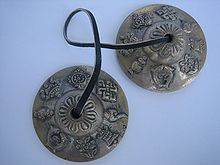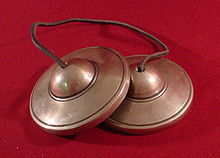Tingsha
The tingsha ( Tibetan ting shag ) is a Tibetan hand cymbal . It consists of two metal basins that are connected to one another with a band. Tingshas are often decorated with the eight Buddhist symbols of good luck (Sanskrit ashtamangala ), a parasol ( chhatra ), treasure vase, fish, lotus blossom , victory banner, endless knot, wheel and conch shell . The cymbals are struck either at right angles to each other or horizontally. A clear, penetrating sound is produced when it is struck, which is repeated as soon as the previous impact has died away.
In Tibetan Buddhism , tingshas are used in various rituals: in personal prayer for escorting the dead, making offerings for the dead and making offerings for the ghosts of hunger . The tingsha is also often used as an offering on the Tibetan altar. In the Tibetan music they are not used. In Tibetan ritual music, larger pair cymbals are used instead: the horizontally struck rol-mo and the vertically struck silnyen .
In the west, tingshas are considered to be the most famous musical instruments of Tibet, along with Tibetan singing bowls, and are available in various Asian and esoteric shops.

